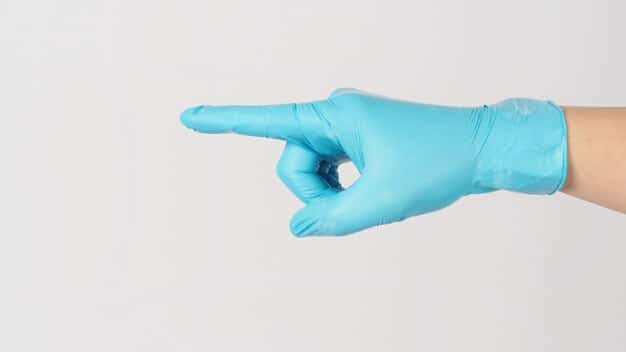How to Identify & Treat Top 5 STIs in Men by 2025

A comprehensive guide on how to identify and treat the five most prevalent sexually transmitted infections in men, outlining key symptoms and effective management strategies for better sexual health by January 2025.
Navigating the landscape of sexual health can feel daunting, but understanding and addressing sexually transmitted infections (STIs) is a crucial step towards well-being. This guide delves into how to identify and treat the 5 most common STIs in men by January 2025, offering clear, actionable insights.
Understanding the Landscape of Male STIs
Sexually transmitted infections are a significant public health concern, impacting millions globally each year. For men, recognizing the signs and understanding effective treatment protocols is paramount for personal health and community well-being. This section lays the groundwork by exploring the broader context of STIs in men.
The Centers for Disease Control and Prevention (CDC) consistently report high rates of certain STIs, particularly among younger populations. Many STIs can be asymptomatic, meaning they show no visible signs, which complicates early detection and can lead to unintended transmission. The societal stigma surrounding STIs often deters individuals from seeking timely testing and treatment, further exacerbating the issue.
The Importance of Early Detection
Early detection of STIs is crucial not only for prompt treatment but also for preventing long-term health complications. Untreated STIs can lead to serious health issues, including infertility, chronic pain, and an increased risk of transmitting or acquiring HIV. Regular screening, especially for those who are sexually active with multiple partners or new partners, is a cornerstone of responsible sexual health management.
- Asymptomatic Nature: Many STIs, like chlamydia and gonorrhea, often present with no symptoms, making routine testing vital.
- Preventing Complications: Early treatment can prevent severe complications such as epididymitis, prostatitis, and permanent damage to reproductive organs.
- Reducing Transmission: Diagnosing and treating an STI quickly halts its potential spread to others, protecting sexual partners.
Education plays a pivotal role in demystifying STIs. Understanding how they are transmitted, their potential impact, and the straightforward steps for testing and treatment empowers individuals to take control of their sexual health. This involves open conversations with healthcare providers and sexual partners, fostering an environment of trust and transparency.
Chlamydia: The Silent Epidemic
Chlamydia remains one of the most common bacterial STIs, often referred to as a “silent” infection because a significant number of infected individuals, especially men, experience no symptoms. Caused by the bacterium Chlamydia trachomatis, it can infect the penis, rectum, or throat.
For men, if symptoms do appear, they typically emerge 1 to 3 weeks after exposure. These might include a discharge from the penis that is cloudy or watery, painful urination (dysuria), or tenderness and pain in one or both testicles. Rectal infections can cause discomfort, discharge, or bleeding, while throat infections are usually asymptomatic but can sometimes lead to a sore throat.
Diagnosis and Treatment Protocols
Diagnosing chlamydia in men usually involves a simple urine test. If a person has engaged in anal or oral sex, swabbing the rectum or throat might also be necessary. It’s crucial to be honest with healthcare providers about all sexual activities to ensure comprehensive testing.
- Urine Test: The most common method, highly accurate for penile infections.
- Swab Tests: Used for rectal or throat infections, particularly if symptoms are present or there’s a history of receptive anal or oral sex.
- Nucleic Acid Amplification Tests (NAATs): These are highly sensitive tests that detect the genetic material of the bacterium.
Treatment for chlamydia is straightforward and highly effective with antibiotics. A single dose of azithromycin or a 7-day course of doxycycline are the most common treatments. It is imperative to complete the entire course of medication, even if symptoms improve or disappear, to ensure the infection is fully eradicated. Sexual activity should be avoided for seven days after completing treatment to prevent re-infection or spreading the infection to partners. All sexual partners should also be tested and treated. While effective, treatment does not prevent future chlamydia infections.
Gonorrhea: The “Clap” Revisited
Gonorrhea, or “the clap,” is another highly prevalent bacterial STI, caused by the bacterium Neisseria gonorrhoeae. Similar to chlamydia, it can infect the urethra, rectum, and throat in men. While often asymptomatic, symptoms, when present, can be more noticeable than those of chlamydia, usually appearing 2 to 14 days after exposure.
Common symptoms in men include a thick, pus-like discharge from the penis, often yellow, white, or green. Painful urination is also a frequent complaint, sometimes accompanied by painful or swollen testicles. Rectal infections may cause discharge, anal itching, soreness, bleeding, or painful bowel movements. Throat infections are usually asymptomatic.
Advanced Diagnostics and Combination Therapy
Diagnosis of gonorrhea typically involves a urine test, or swabs from the urethra, rectum, or throat, depending on exposure risks. Given the increasing concern about antibiotic resistance, accurate and timely diagnosis is critical.
Treatment for gonorrhea has evolved due to rising antibiotic resistance. The CDC currently recommends a dual therapy approach, combining an injectable antibiotic (ceftriaxone) with an oral antibiotic (azithromycin). This combination therapy aims to ensure effective eradication of the bacteria and helps to combat resistance. As with chlamydia, men undergoing treatment should refrain from sexual activity until both they and their partners have completed treatment and are confirmed cured. Follow-up testing is often recommended to confirm treatment success, especially in cases of suspected resistance.
Syphilis: The Great Imitator

Syphilis, caused by the bacterium Treponema pallidum, earned the moniker “the great imitator” because its symptoms can mimic those of many other diseases. It progresses through distinct stages: primary, secondary, latent, and tertiary, each with its own set of manifestations.
The primary stage typically involves the appearance of a single, firm, round, painless sore, called a chancre, at the site where the bacteria entered the body. This can be on the penis, scrotum, anus, rectum, or mouth. The chancre usually appears 10 to 90 days after exposure and can often go unnoticed due to its painless nature and location. It heals on its own within 3 to 6 weeks, even without treatment.
From Primary to Tertiary Stages and Treatment
If primary syphilis is left untreated, it can progress to the secondary stage, characterized by a non-itchy skin rash that can appear on any part of the body, including the palms of the hands and soles of the feet. Other symptoms may include fever, swollen lymph glands, sore throat, patchy hair loss, headaches, muscle aches, and fatigue. These symptoms also typically resolve without treatment, but the infection remains.
The latent stage follows the secondary stage, where there are no visible signs or symptoms of syphilis. This stage can last for years. Without treatment, syphilis can then progress to the tertiary stage, which can affect multiple organ systems, leading to severe complications involving the heart, brain, nerves, and other organs, potentially resulting in disability or death. Neurosyphilis and ocular syphilis can occur at any stage of the disease.
Diagnosis for syphilis involves blood tests that detect antibodies to the bacteria. In some cases, fluid from a chancre may be examined under a microscope. Treatment depends on the stage of syphilis. For primary, secondary, or early latent syphilis, a single intramuscular injection of penicillin G is usually sufficient. Late latent syphilis or tertiary syphilis requires multiple doses of penicillin. For individuals allergic to penicillin, alternative antibiotics may be used, though penicillin remains the preferred treatment. Regular follow-up blood tests are essential to confirm the success of treatment, especially for later stages.
Herpes: The Persistent Viral Foe
Genital herpes, caused by the herpes simplex virus (HSV), is a chronic, lifelong viral infection. There are two types of HSV: HSV-1 (which commonly causes oral herpes but can also cause genital herpes) and HSV-2 (which is the primary cause of genital herpes). Once infected, the virus remains in the body, capable of causing recurrent outbreaks.
The primary outbreak, which occurs days to weeks after exposure, is typically the most severe. Symptoms can include painful blisters or sores on the penis, scrotum, buttocks, inner thighs, anus, or mouth. These blisters eventually break open, forming ulcers that crust over and heal. Other symptoms during a primary outbreak can include fever, body aches, swollen lymph nodes, headache, and a burning sensation during urination. Subsequent outbreaks are usually less severe and of shorter duration, often preceded by tingling or itching at the site where blisters will appear.
Managing Outbreaks and Prevention
Diagnosis of herpes is typically made by visual examination of sores, culturing fluid from a sore, or blood tests to detect antibodies to HSV. Blood tests can identify whether a person has been infected with HSV even if they have no visible sores, distinguishing between HSV-1 and HSV-2.
- Visual Inspection: A healthcare provider can often diagnose herpes by observing the characteristic sores.
- Viral Culture: A sample from a sore can be sent to a lab to grow the virus and confirm its presence.
- PCR Test: A highly sensitive test that detects the genetic material of the virus in a sample from a sore.
- Blood Test: Detects antibodies to HSV, indicating past exposure to the virus.
While there is no cure for herpes, antiviral medications can effectively manage symptoms, reduce the frequency, duration, and severity of outbreaks, and lower the risk of transmission to partners. Common antiviral drugs include acyclovir, valacyclovir, and famciclovir. These can be taken episodically during an outbreak or as daily suppressive therapy for individuals with frequent outbreaks or those wishing to reduce transmission risk to partners. Consistent and correct use of condoms can help reduce but not eliminate the risk of transmission, as the virus can be shed from areas not covered by a condom. Open communication with partners about herpes status is also crucial.
HIV: Understanding and Prevention

Human Immunodeficiency Virus (HIV) is a virus that attacks the body’s immune system. If not treated, it can lead to AIDS (acquired immunodeficiency syndrome). Thankfully, with advancements in medicine, HIV is now a manageable chronic condition, especially when diagnosed and treated early. HIV is primarily transmitted through specific bodily fluids, including blood, semen, pre-seminal fluid, rectal fluids, vaginal fluids, and breast milk, most commonly during unprotected sexual intercourse or sharing injection drug equipment.
Within a few weeks of infection, some people may experience flu-like symptoms (e.g., fever, sore throat, fatigue, rash, muscle aches, swollen lymph nodes) known as acute retroviral syndrome (ARS). However, many people remain asymptomatic for years, making testing crucial for early diagnosis.
Testing, Treatment, and Prevention Strategies
HIV can be diagnosed through various tests, including antibody tests, antigen/antibody tests, and nucleic acid tests (NATs). Rapid tests, using blood or oral fluid, can provide results in 20 minutes or less, though a confirmatory test is often needed. Regular testing is recommended for anyone with risk factors, and awareness of one’s HIV status is foundational for both personal health management and preventing onward transmission.
- Antibody Tests: Detect HIV antibodies in blood or oral fluid.
- Antigen/Antibody Tests: Detect both HIV antibodies and antigens (a part of the virus).
- Nucleic Acid Tests (NATs): Detect viral load (the amount of virus in the blood), typically used for early detection or to confirm other test results.
HIV treatment involves antiretroviral therapy (ART), a regimen of medications that can significantly suppress the virus, allowing people with HIV to live long, healthy lives and preventing the progression to AIDS. ART works by reducing the amount of HIV in the body (viral load) to very low, often undetectable levels. When a person’s viral load is undetectable, they cannot sexually transmit HIV to others, a concept known as “Undetectable = Untransmittable” (U=U).
Prevention strategies extend beyond condom use. Pre-Exposure Prophylaxis (PrEP) involves taking a daily medication to prevent HIV infection in individuals who are HIV-negative but at high risk. Post-Exposure Prophylaxis (PEP) is a medication regimen taken after potential exposure to HIV to prevent infection. Both PrEP and PEP are highly effective tools in the fight against HIV transmission. Early education, consistent testing, and adherence to treatment or prevention strategies are key to curbing the epidemic.
Proactive Steps for Sexual Health in 2025
As we approach January 2025, the emphasis on proactive sexual health management for men becomes increasingly vital. This involves not only understanding the specific STIs discussed but also integrating responsible behaviors into daily life. Personal responsibility, coupled with informed healthcare decisions, forms the bedrock of a healthy sexual life.
Regular communication with healthcare providers is non-negotiable. Men should feel empowered to discuss their sexual health openly, addressing concerns, past exposures, and future risk mitigation strategies. Healthcare providers can offer personalized advice, recommend appropriate screening schedules, and provide prescriptions for preventive measures like PrEP if necessary.
Building a Foundation of Informed Choices
Informed consent and transparent communication with sexual partners are equally crucial. Discussing STI status and promoting mutual testing before engaging in sexual activity can significantly reduce transmission risks. This fosters a relationship built on trust and shared responsibility for sexual well-being.
Beyond individual actions, broader societal shifts are necessary. Reducing the stigma associated with STIs and promoting comprehensive sexual health education from an early age can help normalize conversations and encourage proactive behavior. Access to affordable and confidential testing and treatment services is also fundamental to ensuring equitable sexual health outcomes for all men.
Ultimately, a holistic approach to sexual health for men by January 2025 means being knowledgeable about common STIs, embracing regular testing, adhering to treatment protocols, and engaging in open, honest communication with both healthcare providers and sexual partners. These steps collectively contribute to healthier individuals and communities, transforming the narrative around STIs from one of fear to one of empowerment and prevention.
| Key Point | Brief Description |
|---|---|
| 🔬 Early Detection | Crucial for preventing long-term complications and reducing transmission. |
| 💊 Timely Treatment | Antibiotics or antivirals effectively manage and can cure most common STIs. |
| 🗣️ Open Communication | Discussing sexual health with partners and providers is essential for prevention. |
| 🛡️ Prevention Strategies | Condom use, PrEP, and PEP are critical tools against STI/HIV transmission. |
Frequently Asked Questions About Male STIs
The five most common STIs discussed in this guide for men are Chlamydia, Gonorrhea, Syphilis, Herpes (genital), and HIV. Each has distinct characteristics but shares the commonality of requiring prompt identification and treatment for effective management and prevention of long-term health issues.
The frequency of STI testing depends on individual risk factors, such as the number of partners and sexual behaviors. Generally, sexually active men should consider annual screenings. Those with multiple partners, new partners, or those engaged in receptive anal sex should consider testing more frequently, possibly every 3-6 months.
Bacterial STIs such as chlamydia, gonorrhea, and syphilis are curable with antibiotics, especially when treated early. Viral STIs like herpes and HIV are not curable but can be effectively managed with antiviral medications, which significantly reduce symptoms, outbreaks, and transmission risk.
Untreated STIs can lead to serious long-term health complications. For men, these may include infertility (due to epididymitis or urethral scarring), chronic pain, an increased risk of acquiring or transmitting HIV, and severe organ damage (e.g., from tertiary syphilis affecting the heart or brain).
Yes, it is possible to contract various STIs from oral sex. Infections such as gonorrhea, chlamydia, syphilis, and herpes can be transmitted through oral contact with genitals or anus. Using barriers like condoms or dental dams can reduce the risk of transmission during oral sex.
Conclusion: Empowering Men for Sexual Health
As we navigate towards January 2025, the journey to optimal sexual health for men is paved with knowledge, proactivity, and open dialogue. Identifying and treating the most common STIs is not merely a medical task but a collective responsibility that promotes well-being and prevents widespread health issues. By understanding the nuances of chlamydia, gonorrhea, syphilis, herpes, and HIV, men are empowered to take decisive steps: regular screening, adherence to treatment, and honest communication with partners and healthcare providers. This comprehensive approach is not just about managing infections but fostering a culture of sexual wellness where informed choices lead to healthier lives for all.





